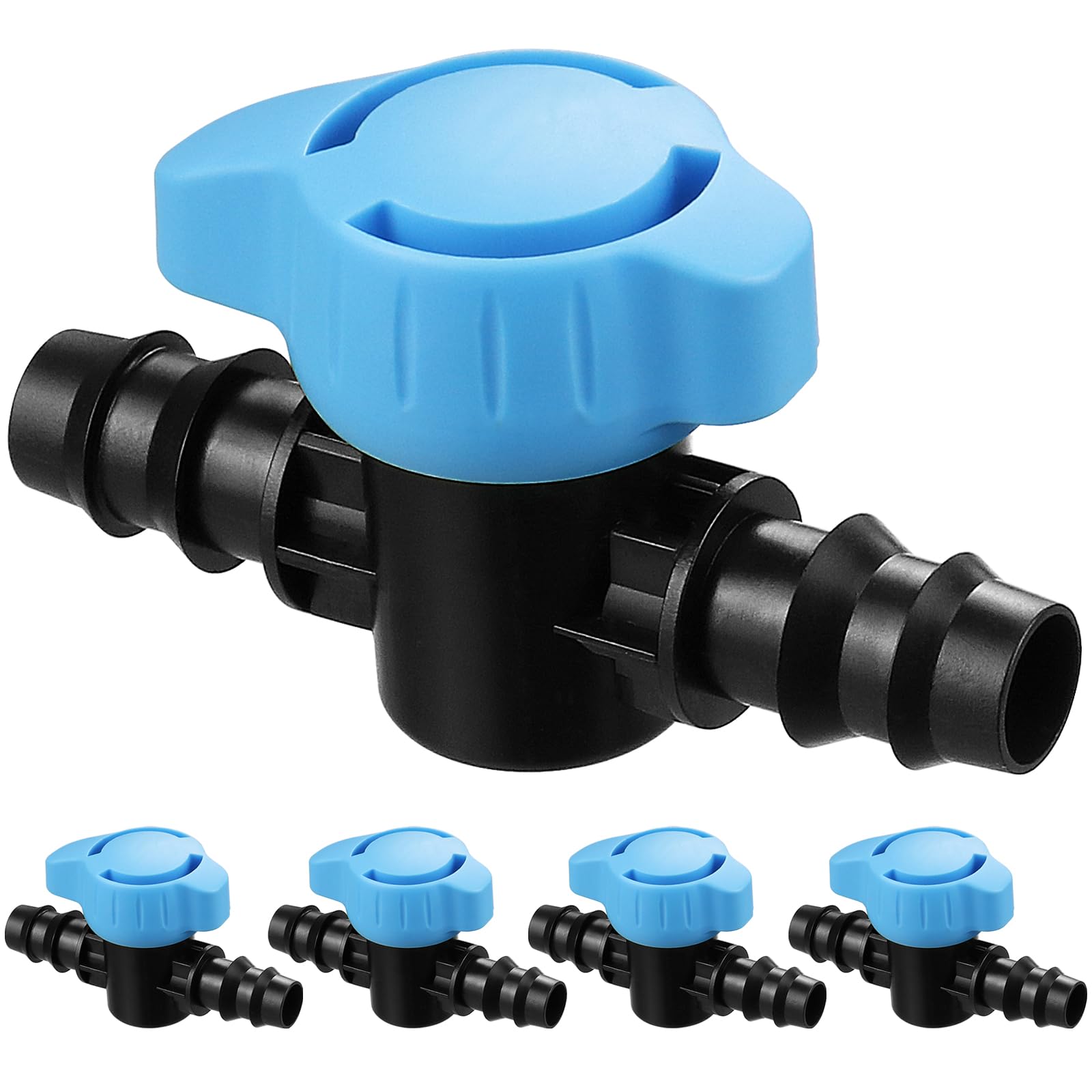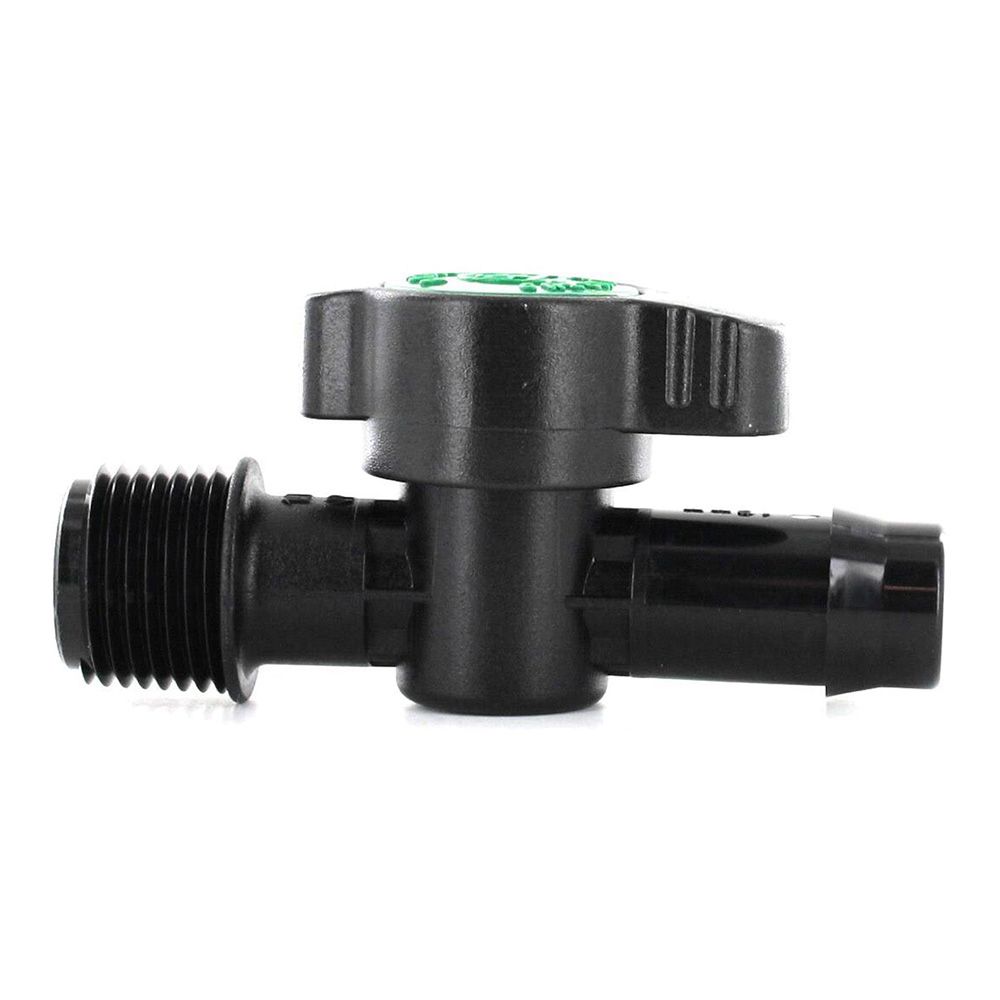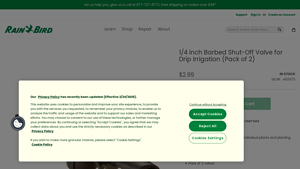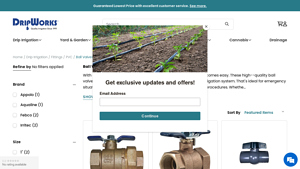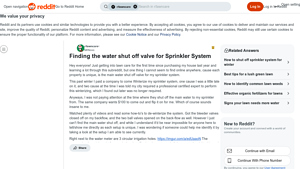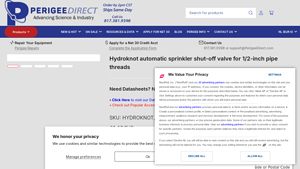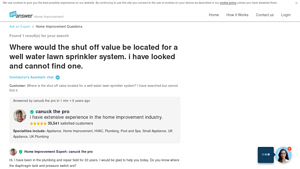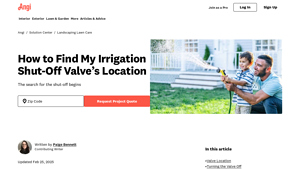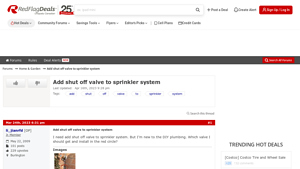Introduction: Navigating the Global Market for irrigation system shut off valve
Navigating the complexities of the global market for irrigation system shut-off valves can pose significant challenges for B2B buyers, particularly when sourcing reliable and efficient solutions tailored to diverse agricultural needs. As water management becomes increasingly critical in regions like Africa, South America, the Middle East, and Europe, understanding the various types of shut-off valves—ranging from barbed and ball valves to more sophisticated automated options—becomes essential. This comprehensive guide delves into the applications of these valves, their critical role in preventing water wastage, and the nuances of supplier vetting, ensuring you select products that meet both operational and regulatory standards.
In this guide, we aim to empower international B2B buyers by providing actionable insights into the cost considerations, installation requirements, and maintenance practices associated with irrigation shut-off valves. By exploring the specific needs and challenges faced by different markets, including those in developing regions like Vietnam and Brazil, we equip businesses with the knowledge necessary to make informed purchasing decisions. As you navigate this essential component of irrigation systems, you will gain the confidence to enhance water management strategies that contribute to sustainable agricultural practices and improve yield outcomes.
Understanding irrigation system shut off valve Types and Variations
| Type Name | Key Distinguishing Features | Primary B2B Applications | Brief Pros & Cons for Buyers |
|---|---|---|---|
| Ball Valve | Simple design, easy to operate, available in various sizes | General irrigation systems, emergency shut-offs | Pros: Durable, reliable; Cons: Requires space for operation. |
| Barbed Shut-Off Valve | Compact, ideal for drip irrigation, adjustable flow control | Drip irrigation systems, container gardening | Pros: Easy installation; Cons: Limited to low-pressure applications. |
| Gate Valve | Offers precise flow regulation, often used in larger systems | Agricultural irrigation, industrial applications | Pros: Excellent flow control; Cons: Slower operation and maintenance. |
| Pressure Relief Valve | Automatically releases excess pressure, protecting system integrity | High-pressure irrigation systems, safety applications | Pros: Prevents damage; Cons: May require regular maintenance. |
| Electric Solenoid Valve | Remote control operation, integrates with automation systems | Smart irrigation systems, large-scale installations | Pros: Convenient and efficient; Cons: Higher upfront costs. |
What Are the Characteristics of Ball Valves?
Ball valves are a staple in irrigation systems, known for their straightforward design and ease of use. They feature a spherical disc that controls flow, making them ideal for both emergency shut-offs and routine maintenance. Available in various sizes, these valves can be installed anywhere in the irrigation system. When considering a ball valve, buyers should evaluate the size requirements and installation space, ensuring compatibility with existing systems.
How Do Barbed Shut-Off Valves Function?
Barbed shut-off valves are particularly suited for drip irrigation systems due to their compact size and ease of installation. They feature barbed ends that ensure a leak-free connection to 1/4″ drip tubing, allowing for precise flow control to individual plants or zones. These valves are ideal for container gardening and small-scale irrigation projects. Buyers should consider the pressure ratings and compatibility with existing drip systems when selecting barbed shut-off valves.
Why Choose Gate Valves for Irrigation?
Gate valves are designed for precise flow regulation, making them suitable for larger irrigation systems. They provide a robust option for agricultural applications where controlling water flow is critical. While they offer excellent flow control, gate valves can be slower to operate and may require more maintenance than other types. B2B buyers should assess the operational needs and maintenance capabilities of their teams when considering gate valves.
What Are the Benefits of Pressure Relief Valves?
Pressure relief valves are essential for high-pressure irrigation systems, automatically releasing excess pressure to prevent damage. These valves ensure the integrity of the irrigation system, especially in agricultural and industrial applications. While they are crucial for safety, pressure relief valves may require regular maintenance to ensure optimal performance. Buyers should factor in the operational environment and potential maintenance needs when evaluating these valves.
How Do Electric Solenoid Valves Enhance Irrigation Systems?
Electric solenoid valves are integral to modern smart irrigation systems, allowing for remote operation and integration with automation technologies. They are particularly beneficial for large-scale installations where manual operation would be inefficient. Although they offer convenience and efficiency, the initial investment can be higher compared to mechanical valves. Buyers should weigh the long-term operational benefits against upfront costs when considering electric solenoid valves.
Key Industrial Applications of irrigation system shut off valve
| Industry/Sector | Specific Application of irrigation system shut off valve | Value/Benefit for the Business | Key Sourcing Considerations for this Application |
|---|---|---|---|
| Agriculture | Control water flow in crop irrigation systems | Prevents over/under-watering, enhancing yield | Durability in harsh climates, compatibility with existing systems |
| Horticulture | Manage water supply to greenhouse plants | Optimizes plant growth and reduces water wastage | UV resistance, precise flow control, ease of installation |
| Landscaping | Regulate water flow for landscape irrigation systems | Ensures uniform watering, reducing costs and labor | Size options, material quality, maintenance requirements |
| Municipal Water Management | Emergency shut-off for public irrigation systems | Minimizes water loss and environmental impact | Compliance with local regulations, availability of parts |
| Industrial Parks and Facilities | Control irrigation for green spaces within commercial properties | Enhances aesthetic appeal and property value | Customization options, installation support, warranty terms |
How is the ‘Irrigation System Shut Off Valve’ Used in Agriculture?
In the agriculture sector, irrigation system shut-off valves are essential for managing water distribution across various crops. These valves allow farmers to control the flow of water to different fields or sections of their farm, preventing over or under-watering, which can lead to crop failure. Buyers in this sector should consider valves that can withstand harsh environmental conditions, ensuring durability and reliability in regions with extreme weather patterns, particularly in Africa and South America.
What Role Does the Shut-Off Valve Play in Horticulture?
Horticulturists utilize shut-off valves to manage water supply in greenhouses and nurseries. These valves enable precise control over the watering of plants, optimizing growth conditions while minimizing water usage. For international buyers, especially in regions with limited water resources, sourcing valves that provide UV resistance and easy adjustment features is crucial to ensure long-term functionality and efficiency.
Why are Shut-Off Valves Important in Landscaping?
In landscaping, shut-off valves regulate water flow in irrigation systems, ensuring that gardens and lawns receive the appropriate amount of water. This regulation not only promotes healthy plant growth but also reduces water waste, ultimately lowering operational costs. Buyers should prioritize valves that offer a range of size options and material quality to match the specific requirements of their irrigation setups, especially in Europe where sustainability is increasingly important.
How Do Shut-Off Valves Benefit Municipal Water Management?
Municipalities employ irrigation system shut-off valves to manage public parks and green spaces effectively. These valves are critical for emergency situations, allowing for quick shut-off to prevent water loss during leaks or repairs. When sourcing these valves, municipalities must ensure compliance with local regulations and availability of replacement parts to maintain efficient operations.
In What Ways Do Shut-Off Valves Enhance Industrial Parks?
In industrial parks, irrigation system shut-off valves help maintain the landscaping that enhances the overall aesthetic of commercial properties. Proper irrigation contributes to a more appealing environment, which can increase property value. Buyers should look for valves that offer customization options and robust installation support to ensure that their irrigation systems function optimally in diverse conditions.
3 Common User Pain Points for ‘irrigation system shut off valve’ & Their Solutions
Scenario 1: Difficulty in Managing Water Flow for Diverse Plant Needs
The Problem: In agricultural settings, particularly in regions like Africa and South America, B2B buyers often face the challenge of managing water flow to different types of crops with varying moisture requirements. This lack of control can lead to over-watering or under-watering, affecting crop health and yield. Additionally, without an efficient irrigation system shut-off valve, adjusting the water supply during maintenance or emergencies becomes cumbersome, risking crop loss.
The Solution: To address this issue, buyers should invest in high-quality, adjustable shut-off valves that allow for precise control of water flow. For instance, a barbed shut-off valve can easily be integrated into drip irrigation systems, providing a straightforward way to regulate water delivery to specific zones. Buyers should consider sourcing valves that feature a top cap for easy adjustment; this facilitates quick changes in flow rate, ensuring optimal watering tailored to the needs of each plant type. Furthermore, establishing a routine maintenance schedule to inspect these valves will help prevent malfunctions, ensuring that the irrigation system operates efficiently year-round.
Scenario 2: Emergency Situations and Quick Response Needs
The Problem: When emergencies arise, such as leaks or bursts in the irrigation system, time is of the essence. B2B buyers must act quickly to shut off water flow to prevent extensive damage. However, the inability to locate or operate the irrigation shut-off valve efficiently can exacerbate the situation, leading to costly repairs and water wastage.
The Solution: To mitigate this risk, it is crucial for buyers to have a clear understanding of their irrigation system layout and the location of the shut-off valves. Implementing a systematic labeling and mapping approach can significantly enhance emergency response capabilities. Training staff on the operation of shut-off valves is equally important; they should know how to quickly identify the valve and operate it, typically by turning a lever perpendicular to the pipe to shut off water flow. Additionally, investing in high-quality ball valves that provide a manual shut-off option can further streamline this process. Regular drills and maintenance checks will ensure that all team members are familiar with the system, thereby reducing response times during emergencies.
Scenario 3: Ensuring Compliance with Local Regulations
The Problem: In many regions, including parts of Europe and the Middle East, regulatory compliance regarding irrigation systems is paramount. The installation of shut-off valves often falls under strict guidelines, particularly concerning backflow prevention to protect local water supplies. Failure to comply with these regulations can result in hefty fines and operational setbacks.
The Solution: To ensure compliance, B2B buyers must thoroughly research local irrigation regulations before selecting and installing shut-off valves. Partnering with local suppliers who understand regional requirements can provide valuable insights into the best practices for valve installation. Buyers should opt for valves that are certified to meet local standards, such as those featuring built-in backflow preventers. Regular training for maintenance teams on compliance standards and best practices can also help mitigate risks. Establishing a relationship with regulatory agencies for updates on compliance changes can further safeguard operations, ensuring that the irrigation systems remain both efficient and legally compliant.
By addressing these common pain points with actionable solutions, B2B buyers can enhance their irrigation systems’ effectiveness and reliability, ultimately leading to better agricultural outcomes and reduced operational risks.
Strategic Material Selection Guide for irrigation system shut off valve
What Are the Key Properties of Common Materials Used in Irrigation System Shut-Off Valves?
When selecting materials for irrigation system shut-off valves, several common options are available, each with distinct properties and applications. The most prevalent materials include PVC, brass, stainless steel, and polyethylene. Understanding their characteristics is crucial for making informed purchasing decisions.
What Are the Key Properties of PVC for Irrigation Shut-Off Valves?
PVC (Polyvinyl Chloride) is a widely used material in irrigation systems due to its excellent resistance to corrosion and chemicals. It typically operates effectively at temperatures up to 140°F (60°C) and can handle moderate pressure levels. PVC is lightweight, making it easy to install and handle.
Pros: PVC valves are cost-effective, durable, and resistant to rust and corrosion, which is ideal for various environments, including those with high humidity. Their low manufacturing complexity allows for mass production and affordability.
Cons: However, PVC can become brittle in extreme temperatures, limiting its use in regions with significant temperature fluctuations. Additionally, it may not be suitable for high-pressure applications.
Impact on Application: PVC is compatible with water and various agricultural chemicals, making it a versatile choice for irrigation systems.
Considerations for International Buyers: Compliance with ASTM standards is essential, particularly in regions like Africa and South America, where irrigation systems are often exposed to harsh environmental conditions.
How Does Brass Compare as a Material for Irrigation Shut-Off Valves?
Brass is another popular choice for irrigation shut-off valves, known for its strength and durability. It has a higher temperature and pressure rating than PVC, typically operating efficiently at temperatures up to 200°F (93°C) and higher pressure levels.
Pros: Brass valves are highly resistant to corrosion and provide a robust solution for high-pressure applications. Their longevity and reliability make them suitable for both residential and commercial irrigation systems.
Cons: The primary disadvantage of brass is its cost, which is generally higher than PVC. Additionally, brass can be susceptible to dezincification in certain water conditions, which may lead to structural failure over time.
Impact on Application: Brass is compatible with water and many agricultural chemicals, making it suitable for various irrigation scenarios.
Considerations for International Buyers: Buyers should ensure compliance with relevant standards such as ASTM and JIS, especially in regions like Europe and the Middle East, where quality assurance is paramount.
What Are the Benefits of Stainless Steel for Irrigation Shut-Off Valves?
Stainless steel is an excellent material for irrigation shut-off valves due to its exceptional corrosion resistance and strength. It can withstand high temperatures (up to 400°F or 204°C) and pressure, making it ideal for demanding applications.
Pros: The durability of stainless steel ensures a long lifespan, minimizing the need for replacements. Its resistance to corrosion makes it suitable for use in various environmental conditions, including saline or acidic soils.
Cons: The main drawback of stainless steel is its higher cost compared to PVC and brass. Additionally, the manufacturing process can be more complex, leading to longer lead times.
Impact on Application: Stainless steel valves are compatible with a wide range of media, including water, chemicals, and fertilizers.
Considerations for International Buyers: Compliance with international standards such as DIN is crucial, particularly in European markets where quality and safety standards are stringent.
Why Choose Polyethylene for Irrigation Shut-Off Valves?
Polyethylene is a flexible and lightweight material commonly used in irrigation systems, especially for drip irrigation applications. It can handle temperatures up to 140°F (60°C) and moderate pressures.
Pros: Polyethylene valves are resistant to corrosion and can be easily molded into various shapes, facilitating custom applications. They are also cost-effective and lightweight, which simplifies installation.
Cons: However, polyethylene may not withstand high pressures and can degrade under UV exposure if not properly treated.
Impact on Application: Polyethylene is suitable for water and some fertilizers, making it a practical choice for agricultural irrigation systems.
Considerations for International Buyers: Buyers should be aware of local regulations regarding the use of polyethylene in irrigation systems, especially in regions with strict environmental standards.
Summary Table of Material Properties for Irrigation System Shut-Off Valves
| Material | Typical Use Case for Irrigation System Shut-Off Valve | Key Advantage | Key Disadvantage/Limitation | Relative Cost (Low/Med/High) |
|---|---|---|---|---|
| PVC | General irrigation systems | Cost-effective and durable | Brittle in extreme temperatures | Low |
| Brass | High-pressure irrigation systems | Strong and corrosion-resistant | Higher cost and dezincification risk | Medium |
| Stainless Steel | High-temperature and high-pressure applications | Exceptional durability | Higher cost and complex manufacturing | High |
| Polyethylene | Drip irrigation systems | Lightweight and flexible | Limited pressure tolerance | Low |
This strategic material selection guide aims to provide B2B buyers with actionable insights into the materials used in irrigation system shut-off valves, facilitating informed purchasing decisions tailored to their specific regional needs and compliance requirements.
In-depth Look: Manufacturing Processes and Quality Assurance for irrigation system shut off valve
What Are the Main Stages of Manufacturing an Irrigation System Shut Off Valve?
The manufacturing of irrigation system shut-off valves involves several critical stages that ensure the final product meets quality and performance standards. Understanding these stages can help B2B buyers assess potential suppliers more effectively.
Material Preparation: What Materials Are Used in Manufacturing?
The first step in the manufacturing process is the selection and preparation of raw materials. Common materials used for irrigation shut-off valves include high-density polyethylene (HDPE), PVC, and brass. These materials are chosen for their durability, resistance to corrosion, and ability to withstand varying pressure levels.
Before production, materials undergo rigorous quality checks to ensure they meet industry specifications. This step may involve chemical testing and physical inspections to verify the integrity and suitability of materials for irrigation applications.
How Are Shut Off Valves Formed and Assembled?
Once the materials are prepared, the next step is forming. Various techniques are employed depending on the material used:
Injection Molding: Predominantly used for plastic valves, this process involves melting plastic and injecting it into molds to form valve components. This method ensures precision and repeatability, essential for maintaining quality across batches.
Extrusion: This technique is often used for producing long components, such as tubing. The material is forced through a die to create the desired shape, which is then cut to length.
Machining: For metal valves, machining processes like turning, milling, and drilling are utilized to achieve tight tolerances and complex geometries. This is crucial for ensuring that moving parts function smoothly.
After forming, the components are assembled. This stage may involve:
Press-Fitting: Components are pressed together, ensuring a tight seal without the need for additional adhesives or fasteners.
Welding or Soldering: For metal components, welding or soldering may be used to create strong, leak-proof joints.
What Finishing Techniques Are Used to Ensure Quality?
The finishing stage involves surface treatments that enhance the valve’s durability and functionality. Common techniques include:
Coating: Applying a protective layer to prevent corrosion and wear, especially for metal parts exposed to moisture.
Polishing: Ensures smooth surfaces which can reduce friction and improve flow rates.
Testing and Calibration: Each valve is tested for functionality, including pressure tests to ensure they can handle specified operational conditions.
What Quality Assurance Standards Are Relevant to Irrigation System Shut Off Valves?
Quality assurance (QA) is paramount in manufacturing irrigation shut-off valves, particularly for international markets. Adherence to recognized standards is essential to ensure product reliability and safety.
Which International Standards Should B2B Buyers Consider?
ISO 9001: This quality management standard ensures that manufacturers consistently meet customer and regulatory requirements. It covers all aspects of production, from material selection to final inspection.
CE Marking: Required in the European market, CE marking indicates that a product meets EU safety, health, and environmental protection standards.
API Standards: For valves used in more demanding applications, such as oil and gas, API standards ensure that products meet rigorous performance criteria.
What Are the Key Quality Control Checkpoints During Manufacturing?
Quality control (QC) checkpoints are integrated at various stages of the manufacturing process to ensure that the final product meets specifications.
How Do Incoming Quality Control (IQC) Procedures Work?
Incoming Quality Control (IQC) involves inspecting raw materials before they enter the production line. This includes verifying material certifications, conducting physical inspections, and performing initial tests for compliance with specifications.
What Is In-Process Quality Control (IPQC) and Why Is It Important?
In-Process Quality Control (IPQC) occurs during production. This involves monitoring the manufacturing processes and conducting tests at various stages. For example, dimensional checks during machining or pressure testing during assembly ensure that any defects are identified and addressed promptly.
How Is Final Quality Control (FQC) Conducted Before Shipment?
Final Quality Control (FQC) is the last line of defense before products are shipped. This includes comprehensive testing of finished valves, such as:
Pressure Testing: Ensuring that valves can withstand operational pressures without leaks.
Functional Testing: Verifying that the valve opens and closes correctly and that flow rates meet specifications.
Visual Inspection: Checking for defects in finish or assembly.
How Can B2B Buyers Verify Supplier Quality Control?
For international buyers, verifying a supplier’s quality control processes is crucial to ensuring product reliability. Here are some actionable steps to take:
What Role Do Audits Play in Supplier Verification?
Conducting audits of potential suppliers can provide insights into their manufacturing and quality assurance processes. Audits can be either scheduled or surprise visits, allowing buyers to assess compliance with international standards and internal protocols.
How Can Buyers Request Quality Reports and Certifications?
Requesting documentation such as quality reports, certifications, and test results can help buyers evaluate a supplier’s commitment to quality. Look for certifications related to ISO standards, CE marking, and other relevant industry-specific qualifications.
What Are the Benefits of Third-Party Inspections?
Engaging third-party inspection services can add an additional layer of assurance. These independent firms can conduct thorough evaluations of manufacturing processes, quality controls, and final products, providing unbiased insights into supplier capabilities.
What Are the Unique QC Considerations for International Buyers?
When sourcing irrigation system shut-off valves from suppliers in regions like Africa, South America, the Middle East, and Europe, buyers should be aware of specific nuances in quality control.
How Do Regional Regulations Affect Quality Standards?
Different regions may have varying regulations regarding product safety and environmental impact. Familiarizing oneself with local standards can help avoid compliance issues and ensure that products are suitable for the intended market.
Why Is It Important to Understand Cultural and Communication Differences?
Cultural differences can impact quality expectations and communication styles. Establishing clear lines of communication and understanding local practices can facilitate smoother interactions and ensure that quality standards are understood and met.
By comprehensively understanding the manufacturing processes and quality assurance measures for irrigation system shut-off valves, B2B buyers can make informed decisions, ensuring they select reliable suppliers who meet their quality expectations.
Practical Sourcing Guide: A Step-by-Step Checklist for ‘irrigation system shut off valve’
This practical sourcing guide aims to equip B2B buyers with a systematic approach to procuring irrigation system shut-off valves. The checklist will help ensure that you choose high-quality products that meet your specific needs while also considering supplier reliability and compliance with local regulations.
Step 1: Define Your Technical Specifications
Before starting the procurement process, clearly outline your technical requirements. This includes determining the size, material (such as PVC or brass), and type of shut-off valve (e.g., ball valves or barbed valves) needed for your irrigation system. Understanding these specifications is vital to ensure compatibility with your existing infrastructure and to avoid costly mistakes.
Step 2: Research Local Regulations and Standards
Different regions may have specific regulations regarding irrigation systems, particularly concerning backflow prevention and valve installation. Familiarize yourself with local laws to ensure compliance. This step is crucial for avoiding legal complications and ensuring the safety and efficiency of your irrigation system.
Step 3: Evaluate Potential Suppliers
Thoroughly vet potential suppliers to establish their credibility and reliability. Request company profiles, product samples, and references from other businesses in your industry or region. A reputable supplier should have a track record of quality service and product delivery, which can be verified through testimonials and case studies.
Step 4: Request Quotes and Compare Pricing
Once you have a list of potential suppliers, request quotes for the shut-off valves you require. Compare pricing not just for the valves themselves but also for shipping, taxes, and any potential import duties. This comprehensive cost analysis will help you make informed financial decisions and identify the best overall value.
Step 5: Verify Supplier Certifications
Ensure that your chosen suppliers have the necessary certifications and quality assurance processes in place. Certifications such as ISO or local equivalents can indicate a commitment to quality and safety standards. This step is essential for ensuring that the products meet international quality benchmarks, especially if you are sourcing from different continents.
Step 6: Assess After-Sales Support and Warranty Policies
Inquire about the after-sales support and warranty policies offered by suppliers. Understanding their return policy, warranty duration, and customer service responsiveness can save you from potential headaches later on. Reliable support can be a significant factor in maintaining your irrigation system effectively.
Step 7: Finalize the Purchase Agreement
Once you have selected a supplier, ensure that all terms and conditions are clearly outlined in a purchase agreement. This should include payment terms, delivery schedules, and any service agreements for installation or maintenance. A well-defined agreement protects both parties and ensures that expectations are aligned throughout the procurement process.
By following this structured approach, B2B buyers can effectively source irrigation system shut-off valves that meet their operational needs while ensuring compliance and quality.
Comprehensive Cost and Pricing Analysis for irrigation system shut off valve Sourcing
What are the Key Cost Components for Sourcing Irrigation System Shut-Off Valves?
When sourcing irrigation system shut-off valves, understanding the cost structure is critical for B2B buyers. The primary cost components include:
Materials: The choice of materials significantly influences the price. Common materials include PVC, brass, and high-grade plastics. Higher-quality materials may lead to increased durability and longevity, but they also come at a premium.
Labor: Labor costs can vary based on the manufacturing location. In regions with higher labor costs, such as parts of Europe, prices may be higher than in countries with lower labor costs, such as Vietnam or Brazil.
Manufacturing Overhead: This encompasses costs related to factory operations, including utilities, maintenance, and administrative expenses. Efficient production processes can help minimize overhead costs, impacting the final price.
Tooling: Custom tooling for specialized valve designs can add to the initial cost. For standard designs, this cost may be lower, but customization for specific applications can significantly increase the upfront investment.
Quality Control (QC): Ensuring that valves meet quality standards involves additional costs. Rigorous testing and certification processes, particularly for valves intended for agricultural use, can add to the overall expense.
Logistics: Shipping and handling costs are essential considerations, especially for international buyers. Factors such as shipping distance, mode of transportation, and customs duties can significantly affect the total cost.
Margin: Suppliers typically include a profit margin, which can vary based on market demand and competition. Understanding the margin expectations in different regions is crucial for effective negotiation.
How Do Price Influencers Impact the Cost of Shut-Off Valves?
Several factors influence the pricing of irrigation shut-off valves:
Volume and Minimum Order Quantity (MOQ): Larger order volumes usually lead to lower per-unit costs due to economies of scale. Buyers should inquire about MOQs and consider consolidating orders to maximize cost efficiency.
Specifications and Customization: Custom valves designed for specific applications or environments can lead to higher costs. Buyers should evaluate whether customization is necessary or if standard options suffice.
Quality and Certifications: Valves that meet specific quality standards or certifications may come at a premium. Buyers should assess whether these certifications are necessary for their operations to avoid unnecessary expenses.
Supplier Factors: The reputation and reliability of suppliers can impact pricing. Established suppliers with a proven track record may charge higher prices due to their reliability and service quality.
Incoterms: Understanding Incoterms is crucial for international transactions, as they define responsibilities for shipping, insurance, and duties. These terms can affect the overall cost structure significantly.
What Tips Can Buyers Use to Negotiate Better Prices?
International B2B buyers should consider the following strategies to optimize their sourcing of irrigation system shut-off valves:
Leverage Negotiation Skills: Engage suppliers in discussions about pricing, especially when placing large orders. Don’t hesitate to ask for discounts based on volume or long-term partnership commitments.
Evaluate Total Cost of Ownership (TCO): Beyond the initial purchase price, consider the TCO, which includes installation, maintenance, and replacement costs. Investing in higher-quality valves may lead to lower long-term expenses.
Understand Pricing Nuances for Different Regions: Be aware of how regional economic conditions, tariffs, and trade agreements can influence pricing. For instance, sourcing from local suppliers in Africa or South America may reduce shipping costs and lead times.
Seek Multiple Quotes: Obtaining quotes from various suppliers can provide insights into competitive pricing and help in making informed decisions.
Establish Relationships with Suppliers: Building long-term relationships can result in better pricing, priority service, and improved product availability.
Conclusion
In summary, understanding the cost components and pricing influencers of irrigation system shut-off valves is essential for B2B buyers. By applying strategic negotiation techniques and considering the total cost of ownership, buyers can make informed decisions that align with their operational needs and budget constraints. Always remember to account for regional pricing nuances and supplier relationships to maximize sourcing efficiency.
Alternatives Analysis: Comparing irrigation system shut off valve With Other Solutions
Exploring Alternatives to the Irrigation System Shut Off Valve
When evaluating irrigation solutions, it’s essential to consider various alternatives to the traditional irrigation system shut off valve. Each option presents unique advantages and challenges, influencing their suitability based on specific agricultural or landscaping needs. Below, we compare the irrigation system shut off valve with two prominent alternatives: ball valves and automated irrigation controllers.
| Comparison Aspect | Irrigation System Shut Off Valve | Ball Valve | Automated Irrigation Controller |
|---|---|---|---|
| Performance | Provides reliable on/off control for irrigation systems. | Offers manual shutoff, suitable for emergencies and maintenance. | Automates watering schedules and monitors system performance. |
| Cost | Generally low-cost, often under $5. | Mid-range, usually between $10-$50, depending on size and material. | Higher initial investment, typically ranging from $50 to several hundred dollars. |
| Ease of Implementation | Simple installation with basic tools. | Requires some plumbing skills for installation. | Installation can be complex, often requiring programming and setup. |
| Maintenance | Minimal maintenance required; check for leaks periodically. | Requires periodic checks to ensure proper operation; may corrode over time. | Regular software updates and system checks needed; may require troubleshooting. |
| Best Use Case | Ideal for small-scale or manual irrigation systems. | Best for emergency shutoff in larger systems or for maintenance. | Optimal for large-scale operations needing automation and efficiency. |
What Are the Pros and Cons of Using Ball Valves?
Ball Valves are a popular alternative to shut off valves for irrigation systems, providing a manual shutoff option at various points in the irrigation line. They are constructed from durable materials like PVC or brass, ensuring long-lasting performance. The main advantage of ball valves is their straightforward operation, allowing for quick manual control during emergencies or routine maintenance. However, their reliance on manual operation can be a drawback in large installations, where frequent adjustments may be necessary. Additionally, they are typically more expensive than standard shut off valves.
How Do Automated Irrigation Controllers Enhance Irrigation Management?
Automated Irrigation Controllers offer a modern solution for managing irrigation systems, providing programmable schedules and real-time monitoring. These devices can optimize water usage, ensuring plants receive the right amount of water based on their needs. The primary advantage of these systems is their ability to reduce labor costs and improve efficiency through automation. However, they require a higher initial investment and can involve complex installation and programming processes. Maintenance may also be more demanding due to software updates and potential technical issues.
Conclusion: How to Choose the Right Solution for Your Needs
Selecting the appropriate irrigation solution depends on your specific requirements, budget, and the scale of your operation. If you are managing a small garden or landscape, a simple irrigation system shut off valve may be sufficient, offering low cost and easy installation. For larger systems where emergency shutoff is crucial, ball valves provide reliable performance. Alternatively, for extensive agricultural operations aiming for efficiency and automation, investing in an automated irrigation controller may yield the best long-term results. Assess your operational needs carefully to ensure you choose the most effective solution for your irrigation management strategy.
Essential Technical Properties and Trade Terminology for irrigation system shut off valve
What Are the Key Technical Properties of Irrigation System Shut Off Valves?
Understanding the technical properties of irrigation system shut-off valves is crucial for B2B buyers looking to make informed purchasing decisions. Here are some essential specifications that should be considered:
Material Grade
The material used in the construction of shut-off valves significantly influences durability and resistance to environmental factors. Common materials include PVC, brass, and high-grade plastics. For instance, PVC is lightweight and resistant to corrosion, making it ideal for many irrigation applications. Brass, while heavier and more expensive, offers superior strength and longevity. Understanding the material grade helps buyers select valves that will withstand local climate conditions and water quality.Size and Compatibility
Shut-off valves come in various sizes (e.g., 1/4 inch to 2 inches) to accommodate different piping systems. Selecting the correct size ensures optimal flow rates and prevents leaks. Buyers must verify that the valve’s size matches existing infrastructure, as improper sizing can lead to inefficiencies or system failures.Flow Control Mechanism
Valves may feature different flow control mechanisms such as ball, gate, or globe designs. A ball valve, for example, allows for quick shut-off and reliable performance in high-pressure situations. Buyers should consider the type of flow control that best suits their irrigation system’s needs, as this can impact water management efficiency.Pressure Rating
The pressure rating indicates the maximum pressure the valve can withstand without failure. This specification is essential for preventing leaks and ensuring system integrity. Buyers should assess their irrigation system’s operational pressure to select valves that can handle the required demands, especially in regions with varying water pressures.Temperature Tolerance
Valves should be rated for the temperature range of the environment where they will be installed. This is particularly important in regions with extreme weather conditions, as high temperatures can degrade some materials. Buyers need to ensure that the valve can operate effectively within the expected temperature fluctuations.
What Are Common Trade Terms Related to Irrigation Shut Off Valves?
Familiarity with industry jargon can facilitate smoother transactions and negotiations for B2B buyers. Here are some common terms:
OEM (Original Equipment Manufacturer)
This term refers to companies that produce parts or equipment that may be marketed by another manufacturer. For buyers, knowing whether a valve is an OEM product can assure them of quality and compatibility with existing systems.MOQ (Minimum Order Quantity)
MOQ indicates the smallest quantity of a product that a supplier is willing to sell. Understanding MOQ is critical for buyers, especially those in smaller markets, as it affects inventory levels and cash flow.RFQ (Request for Quotation)
An RFQ is a document sent to suppliers requesting pricing and other details for specific products. This is a vital tool for buyers to gather competitive offers and make informed purchasing decisions based on pricing and terms.Incoterms (International Commercial Terms)
These are standardized terms used in international trade to define the responsibilities of buyers and sellers regarding shipping, insurance, and tariffs. Familiarity with Incoterms helps buyers understand their obligations and risks when importing valves from other countries.Backflow Preventer
This is a critical component in irrigation systems that prevents contaminated water from flowing back into the clean water supply. Understanding its importance can guide buyers in selecting valves that are compliant with local regulations and help maintain water quality.Flow Rate
This refers to the volume of water that can pass through a valve in a given time, usually measured in gallons per minute (GPM). Knowing the flow rate is essential for optimizing irrigation efficiency and ensuring that the system meets the specific watering needs of crops or landscapes.
By comprehensively understanding these technical properties and trade terms, B2B buyers can make well-informed decisions that enhance their irrigation systems’ efficiency and reliability.
Navigating Market Dynamics and Sourcing Trends in the irrigation system shut off valve Sector
What Are the Key Trends Influencing the Global Market for Irrigation System Shut Off Valves?
The irrigation system shut off valve sector is experiencing significant growth driven by various global factors. Increasing agricultural demands due to population growth and food security concerns are pushing B2B buyers towards efficient water management solutions. Regions like Africa and South America, with their expanding agricultural sectors, are becoming vital markets for suppliers of irrigation components, including shut off valves.
Emerging technologies, such as smart irrigation systems that utilize IoT devices, are reshaping how these valves are sourced and managed. For instance, automated shut off valves that can be controlled remotely are gaining traction, allowing users to optimize water usage based on real-time data. This trend aligns with the broader movement towards precision agriculture, which aims to maximize output while minimizing resource consumption.
Additionally, the current market dynamics highlight the importance of competitive pricing and quality assurance. International buyers are increasingly seeking suppliers who can offer high-quality products at competitive prices, alongside robust after-sales support. As the market becomes more interconnected, understanding local regulations and standards in different regions, particularly in Europe and the Middle East, is crucial for successful sourcing.
How Is Sustainability Shaping the Sourcing of Irrigation System Shut Off Valves?
Sustainability has emerged as a critical factor influencing the sourcing of irrigation system shut off valves. The environmental impact of agricultural practices is under scrutiny, leading to a heightened focus on sustainable sourcing. B2B buyers are increasingly inclined to partner with suppliers who prioritize eco-friendly materials and manufacturing processes.
The use of recycled materials and the adoption of ‘green’ certifications are becoming essential criteria for procurement decisions. Suppliers that can demonstrate a commitment to sustainability not only enhance their marketability but also contribute to the overall reduction of the irrigation sector’s carbon footprint. For example, valves made from UV-resistant, recyclable plastics not only ensure longevity but also align with sustainability goals.
Moreover, ethical supply chain practices are gaining prominence, as buyers seek to mitigate risks associated with labor exploitation and environmental degradation. Understanding the sourcing practices of suppliers, including their compliance with international labor standards, is crucial for B2B buyers aiming to maintain their brand integrity and corporate social responsibility commitments.
What Is the Historical Context of Irrigation System Shut Off Valves in B2B Markets?
The evolution of irrigation system shut off valves can be traced back to traditional agricultural practices, where manual control of water flow was the norm. As agriculture became more industrialized in the 20th century, the need for efficient water management led to the development of more sophisticated valve systems. Initially, these valves were rudimentary, often made from metal, which presented issues of corrosion and durability.
With advancements in materials science, the introduction of high-quality plastics and composites revolutionized the industry. Modern shut off valves are now designed to withstand harsh environmental conditions while offering greater reliability and ease of use. This evolution has been particularly significant in regions with challenging climates, where robust and efficient irrigation solutions are essential for successful crop production.
Today, the integration of technology into irrigation systems, such as the use of automated valves and smart controls, represents the latest phase in this evolution. This trend not only enhances operational efficiency but also aligns with the increasing demand for sustainable agricultural practices across global markets. As buyers navigate this landscape, understanding the historical context of these products can provide valuable insights into their current and future sourcing strategies.
Frequently Asked Questions (FAQs) for B2B Buyers of irrigation system shut off valve
How do I choose the right irrigation system shut-off valve for my needs?
Selecting the appropriate shut-off valve depends on several factors, including the size of your irrigation system, the type of crops or plants being irrigated, and the specific flow requirements. Assess whether you need a manual or automatic valve based on your operational needs. It’s also crucial to consider the materials used in the valve’s construction, as these affect durability and resistance to environmental conditions. Consult with suppliers about their product range to ensure compatibility with your existing system.What is the best type of shut-off valve for drip irrigation systems?
For drip irrigation systems, barbed shut-off valves are often the best choice. They allow for easy installation and provide a secure, leak-free connection to drip tubing. Barbed ends facilitate quick adjustments to water flow, which is essential for managing different moisture requirements among plants. Additionally, consider valves with UV-resistant materials to ensure longevity in outdoor applications, especially in regions with intense sunlight.What are the typical minimum order quantities (MOQs) for irrigation shut-off valves from international suppliers?
Minimum order quantities can vary significantly based on the supplier and the type of valve. Generally, for bulk purchases, MOQs can range from 100 to 1,000 units. It’s essential to discuss your specific needs with potential suppliers to determine flexibility in MOQs, as some may allow smaller orders depending on your business relationship or if they have excess stock.How can I vet international suppliers for irrigation system shut-off valves?
When vetting international suppliers, start by checking their credentials, including certifications and industry experience. Request references or case studies from past clients, and look for reviews or ratings on trade platforms. It’s also advisable to ask about their production capabilities and quality assurance processes. Consider conducting a factory visit or utilizing third-party inspection services to evaluate their operations before finalizing a partnership.What payment terms should I expect when sourcing shut-off valves internationally?
Payment terms can vary but typically include options like advance payment, letters of credit, or payment on delivery. Many suppliers may request a deposit (often 30-50%) before starting production, with the balance payable upon shipment or delivery. Always clarify payment terms upfront and consider negotiating terms that align with your cash flow needs. Ensure you understand any associated fees, especially for international transactions.What quality assurance measures should I look for in shut-off valves?
Quality assurance is critical in ensuring the reliability and performance of irrigation shut-off valves. Look for suppliers who implement standardized testing procedures, such as pressure testing and durability assessments. Certifications from recognized standards organizations (e.g., ISO, CE) can also provide assurance of product quality. Request documentation of quality checks and consider establishing quality benchmarks that the supplier must meet.How do logistics and shipping impact the procurement of irrigation system shut-off valves?
Logistics play a vital role in the timely delivery of irrigation system shut-off valves. Consider the shipping options available, including air freight for faster delivery or sea freight for cost-effective bulk shipping. Be aware of customs regulations and tariffs that may apply, particularly in your region. Collaborating with a reliable logistics partner can help streamline the shipping process, ensuring that your valves arrive on time and in good condition.What should I do if I need customization for my irrigation shut-off valves?
If you require customized shut-off valves, communicate your specifications clearly to potential suppliers. Many manufacturers offer customization options, such as specific sizes, materials, or flow rates. Be prepared to discuss minimum order quantities and lead times for customized products. Additionally, request samples to verify that the customized valves meet your requirements before committing to a larger order. Always ensure that any customizations align with local regulations and standards.
Important Disclaimer & Terms of Use
⚠️ Important Disclaimer
The information provided in this guide, including content regarding manufacturers, technical specifications, and market analysis, is for informational and educational purposes only. It does not constitute professional procurement advice, financial advice, or legal advice.
While we have made every effort to ensure the accuracy and timeliness of the information, we are not responsible for any errors, omissions, or outdated information. Market conditions, company details, and technical standards are subject to change.
B2B buyers must conduct their own independent and thorough due diligence before making any purchasing decisions. This includes contacting suppliers directly, verifying certifications, requesting samples, and seeking professional consultation. The risk of relying on any information in this guide is borne solely by the reader.
Top 7 Irrigation System Shut Off Valve Manufacturers & Suppliers List
1. Rainbird – 1/4 inch Barbed Shut-Off Valve Pack of 2
Domain: store.rainbird.com
Registered: 1995 (30 years)
Introduction: {“name”:”1/4 inch Barbed Shut-Off Valve for Drip Irrigation (Pack of 2)”,”special_price”:”$2.99″,”list_price”:”$3.50″,”sku”:”A50970″,”quantity”:”Pack of 2 valves”,”features”:[“On/Off or regulated flow”,”Ideal way to control water flow to individual plants and planting containers”,”Top cap turns to adjust water flow”,”1/4 inch barbed ends for easy, leak-free insertion into drip tubing”,”Constructed…
2. DripWorks – High-Quality Ball Valves
Domain: dripworks.com
Registered: 1998 (27 years)
Introduction: Drip Irrigation – Fittings – PVC – Ball Valves. Guaranteed Lowest Price with excellent customer service. High-quality ball valves for manual shutoff in irrigation systems. Available sizes: 1/2″, 3/4″, 1″, up to 2″. Constructed of schedule 40 PVC or brass. Options include threaded, slip valves, and three-way valves. Featured products include: Febco LF Brass Ball Valve w/ Union ($44.65 – $69.95), Fe…
3. Reddit – Water Flow Control Solutions
Domain: reddit.com
Registered: 2005 (20 years)
Introduction: This company, Reddit – Water Flow Control Solutions, is a notable entity in the market. For specific product details, it is recommended to visit their website directly.
4. Perigee Direct – Hydroknot Automatic Sprinkler Valve
Domain: perigeedirect.com
Registered: 2016 (9 years)
Introduction: Hydroknot automatic sprinkler shut-off valve for 1/2-inch pipe threads
5. JustAnswer – Shut-off Valve for Lawn Sprinkler Systems
Domain: justanswer.com
Registered: 2004 (21 years)
Introduction: Shut-off valve for well water lawn sprinkler systems is typically located near the pressure tank or where the main water line enters the irrigation system. It can be found along the main supply pipe, often close to the backflow preventer or filter assembly. Valves may be underground in valve boxes or mounted on risers. Regular inspection and labeling of valves are recommended for easy access. If n…
6. Angi – Irrigation Shut-Off Valve
Domain: angi.com
Registered: 1996 (29 years)
Introduction: The irrigation shut-off valve is typically located near the corners of the house or main building, just downstream of the backflow preventer. It can be found above-ground inside the home (in areas like the garage, utility closet, or basement) or outside in a protective box near the water source. Below-ground valves are usually buried in a valve box with a green lid, often near the water meter or w…
7. Red Flag Deals – Sprinkler Shut-Off Valve
Domain: forums.redflagdeals.com
Registered: 2000 (25 years)
Introduction: Shut-off valve for sprinkler system, suitable for DIY plumbing, designed to control water flow to the sprinkler system, allowing for easy shut-off during summer or for maintenance. Recommended types include PVC ball valve and appropriate adapters for connection between copper line and poly tube. Proper size needed based on threaded fitting (1/2 or 3/4 inch). Hose clamps may be required for install…
Strategic Sourcing Conclusion and Outlook for irrigation system shut off valve
In conclusion, effective strategic sourcing of irrigation system shut-off valves is pivotal for ensuring operational efficiency and reliability in water management. By selecting high-quality valves, such as barbed and ball valves, businesses can enhance their irrigation systems, minimizing water waste and optimizing plant health across various environments. Understanding the specific needs of different agricultural regions—whether in Africa, South America, the Middle East, or Europe—enables buyers to make informed decisions that align with local practices and regulatory standards.
As the global demand for sustainable agricultural practices continues to rise, the importance of sourcing durable and efficient irrigation components cannot be overstated. International B2B buyers should prioritize partnerships with reputable suppliers who offer innovative solutions tailored to their unique challenges.
Looking ahead, the irrigation industry will likely witness advancements in technology, including automated shut-off systems and smart irrigation solutions. Engaging with these innovations will position businesses at the forefront of sustainable practices. Take proactive steps today by exploring the best suppliers and technologies that can elevate your irrigation systems to meet the challenges of tomorrow.

